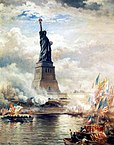Egypt Carrying the Light to Asia
Egypt Carrying the Light to Asia, also known as Progress Carrying the Light to Asia, was a plan for a colossal neoclassical sculpture. Designed in the late 1860s by Frédéric Auguste Bartholdi, a French sculptor, the project was to be a statue of a robed female figure bearing a torch at the entryway of the Suez Canal in Port Said, Egypt.[1][2] The proposed statue was declined by the Khedive, citing the expensive cost,[3] and in 1869 the Port Said Lighthouse, designed by François Coignet, was built in the same location.
In the 1880s Bartholdi designed and built his colossal Liberty Enlightening the World, a robed female figure bearing a torch, which became known as the Statue of Liberty. He placed it in New York Harbor in the United States.
References
- ^ Khan, Yasmin Sabina (2010). Enlightening the World: The Creation of the Statue of Liberty. Cornell University Press. pp. 53–54. ISBN 0-8014-4851-4.
- ^ "The Statue of Liberty Story, From Egypt to New York | The Arab American Historical Foundation Home". www.arabamericanhistory.org. Retrieved 2017-02-22.
- ^ Karabell, Zachary (2003). Parting the desert: the creation of the Suez Canal. Alfred A. Knopf. p. 243. ISBN 0-375-40883-5.

